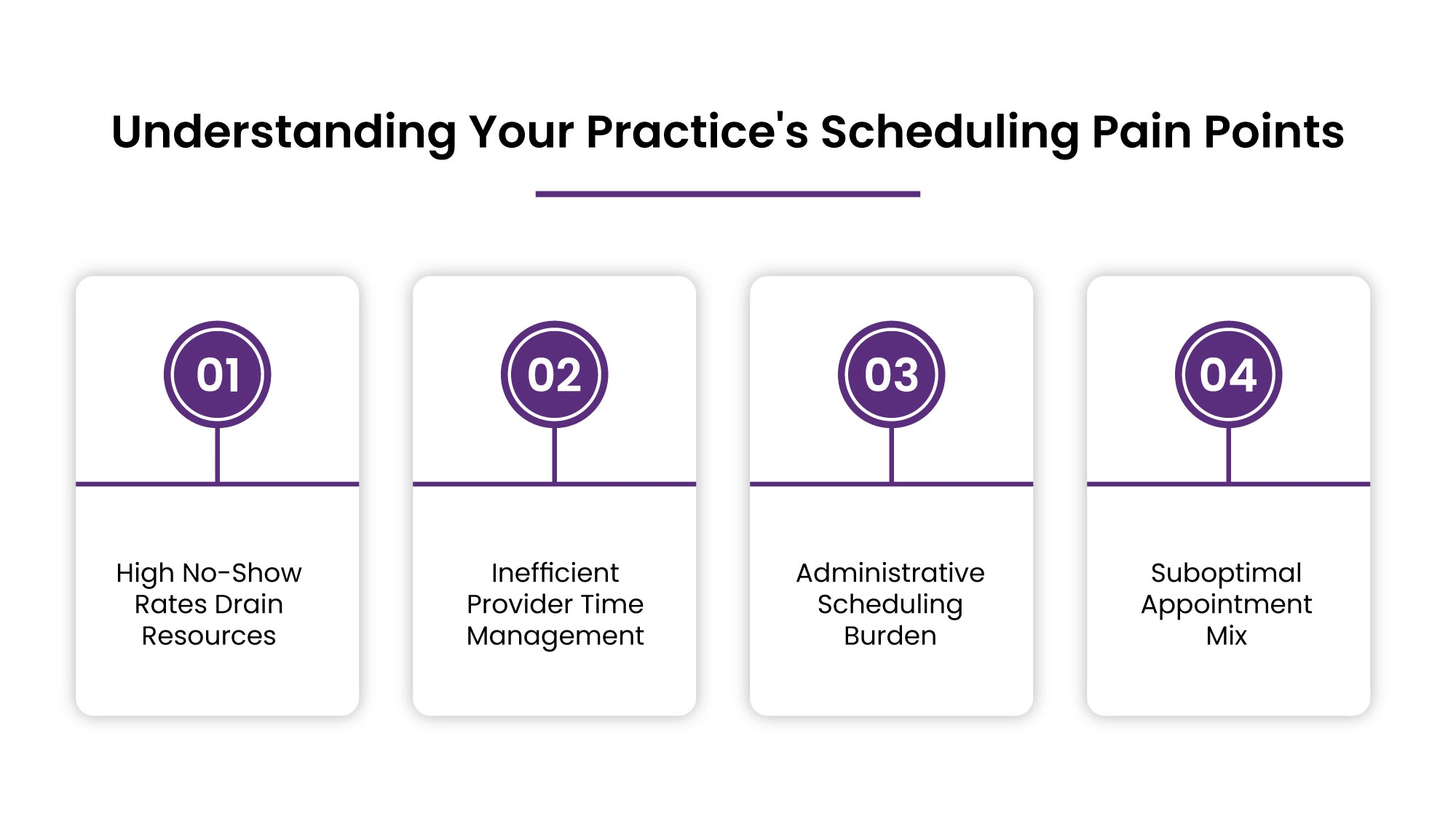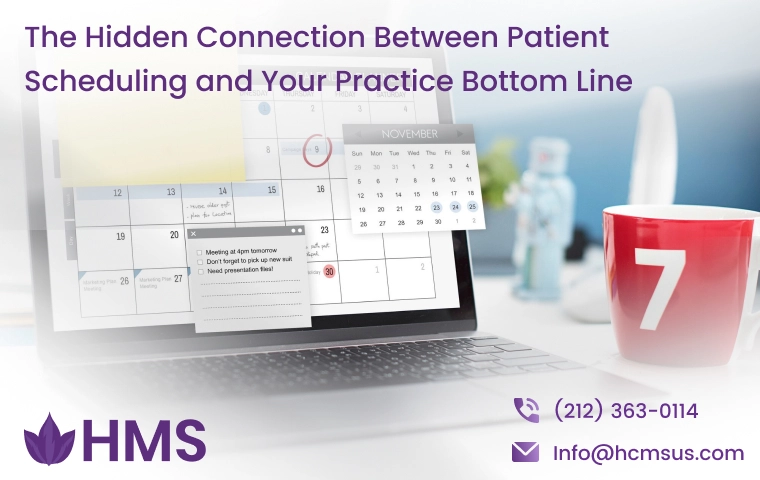Most healthcare providers recognize that delivering quality care is essential to driving practice success. Yet many overlook how their appointment scheduling system directly impacts revenue.
The way you manage your calendar affects everything from provider productivity to patient satisfaction. When patients face long waits or confusing booking processes, they're more likely to cancel, reschedule, or simply never return.
The hidden connection between patient scheduling and your practice bottom line
Understanding Your Practice's Scheduling Pain Points
Before overhauling your scheduling system, take time to identify specific issues impacting your revenue. Common problems include:

1- High No-Show Rates Drain Resources
When patients fail to appear for scheduled appointments, your practice loses not just the immediate revenue from that visit, but also the opportunity cost of serving another patient during that time. Practices with no-show rates exceeding 15% often see significant revenue decline that compounds over time.
2- Inefficient Provider Time Management
Many practices inadvertently create scheduling patterns that leave providers rushed during complex cases or idle during gaps between appointments. Consider whether your current approach maximizes each provider's billable hours while maintaining quality care standards.
3- Administrative Scheduling Burden
Your front office staff likely spends hours each week managing appointment requests, confirming visits, and handling rescheduling. This administrative overhead represents a significant operational cost that smart scheduling strategies can reduce.
4- Suboptimal Appointment Mix
Not all appointment types yield equal revenue. Without careful planning, practices often fill calendars with lower-reimbursing visits while struggling to accommodate more complex, higher-revenue consultations.
Revenue-Focused Scheduling Strategies That Work
Addressing scheduling challenges requires a multifaceted approach tailored to your practice's specific needs. Here are proven strategies that consistently boost revenue:
Implement Strategic Appointment Types
Consider restructuring your appointment offerings based on provider capacity and revenue potential. Create distinct appointment types that reflect the actual time required for different patient needs rather than using a one-size-fits-all approach.
For example, a primary care practice might designate specific slots for acute care visits (15 minutes), follow-ups (20 minutes), annual physicals (40 minutes), and new patient consultations (45 minutes).
This precision scheduling ensures providers have adequate time for complex cases while maximizing the number of appointments possible each day. The revenue impact can be substantial.
Adopt Smart Scheduling Templates
Your scheduling template should reflect the natural workflow patterns of your providers and staff. Many practices benefit from modified wave scheduling, where several patients are scheduled at the beginning of each hour, followed by intentionally open slots to accommodate longer-than-expected visits or urgent add-ons.
Others find success with cluster scheduling, grouping similar appointment types together to improve provider efficiency. For instance, scheduling all diabetic follow-ups on Tuesday mornings allows providers to maintain mental focus on a specific condition, often resulting in more thorough care and appropriate billing.
Minimize No-Shows Through Engagement
No-shows represent pure revenue loss. Reducing them requires a combination of convenience and accountability:
Implement a multi-touch reminder system that contacts patients through their preferred communication channels. Research shows that practices using three reminder methods (text, email, and phone) see no-show rates below 5%, compared to 18% for practices using only one method.
Consider implementing a modest no-show fee policy. While the fee itself rarely covers the lost revenue, communicating this policy reduces no-show rates by creating accountability. Practices that clearly communicate no-show policies experience approximately 30% fewer missed appointments.
Make rescheduling frictionless. When patients know they can easily change an appointment they can't make, they're more likely to notify you rather than simply not showing up.
Leverage Data for Scheduling Decisions
Practice management systems contain valuable data about your scheduling patterns. Analyze this information to identify:
1- High no-show timeframes, which might indicate scheduling during inconvenient hours for your patient population
2- Provider productivity patterns, revealing when each provider performs optimally for different visit types
3- Seasonal variations that affect appointment demand and completion rates
Technology Solutions That Enhance Revenue Through Scheduling
Modern scheduling tools can dramatically improve both efficiency and revenue generation:
Online Self-Scheduling Platforms
Patients increasingly expect the convenience of booking appointments online. Practices offering this option typically see:
-
Reduced administrative costs, as staff spend less time on phone bookings
-
Higher appointment completion rates, particularly among younger patients
-
Extended scheduling hours, as patients can book evenings and weekends
-
Lower no-show rates, typically 3-7% below phone-scheduled appointments
The initial investment in online scheduling typically pays for itself within months through increased efficiency and filled appointments.
Automated Waitlist Management
Every practice has cancellations, but how you handle them determines whether they represent lost revenue or opportunity. Automated waitlist systems immediately notify patients when preferred appointment times become available.
Practices using these systems fill over 80% of cancelled appointments compared to less than 40% for practices relying on manual waitlist management. For a mid-sized practice, this difference can represent tens of thousands in additional annual revenue.
Predictive Analytics for Scheduling
More sophisticated practice management systems now offer predictive analytics that identify patients likely to benefit from follow-up appointments. These tools can prompt staff to proactively schedule patients for necessary follow-up care, improving both clinical outcomes and revenue capture.
Scheduling Strategies for Different Practice Types
Primary Care Practices
Reserve 15-20% of daily appointments for same-day acute visits to capture revenue that might otherwise go to urgent care centers or competitors.
Consider extended hours one or two days weekly to accommodate working patients who might otherwise postpone preventive care.
Surgical Specialties
Block schedule pre-operative consultations on specific days to maximize efficiency in patient education and preparation.
Coordinate post-operative follow-ups during predictably slower periods to maintain steady patient flow.
Therapy and Rehabilitation Practices
Implement recurring appointment scheduling for treatment plans requiring multiple visits, reducing no-shows and administrative work.
Consider offering early morning or evening appointments for working patients who require frequent visits.
Measuring the Impact of Your Scheduling Changes
To ensure your scheduling strategies truly enhance revenue, track these key metrics before and after implementation:
Provider Utilization Rate
Calculate the percentage of available appointment time actually used for patient care. Aim for 85-90% utilization; lower rates indicate scheduling inefficiency while higher rates may compromise quality and cause provider burnout.
Revenue Per Hour
Divide daily or weekly revenue by the number of available provider hours to determine how effectively your scheduling maximizes earning potential.
Appointment Completion Rate
Monitor the percentage of scheduled appointments actually completed. This combines no-shows, cancellations, and reschedules into a single metric that reflects scheduling effectiveness.
Patient Satisfaction Scores
Ensure that revenue-focused scheduling changes don't negatively impact patient experience. Short post-visit surveys can help track satisfaction with appointment availability and wait times.
Final Thoughts
While this article focuses on revenue maximization, remember that patient care remains paramount. The most successful scheduling strategies enhance both financial performance and patient satisfaction.
By implementing these strategies thoughtfully and measuring outcomes consistently, you can transform your appointment schedule from a necessary administrative function into a powerful revenue driver for your healthcare practice.
HMS USA LLC stands out as a leading provider of front office and practice management solutions that help healthcare practices implement effective scheduling systems. Our specialized expertise in optimizing administrative workflows has helped countless medical offices transform their scheduling processes from basic appointment management into strategic revenue drivers.
Our consultative approach ensures that each practice receives customized scheduling strategies aligned with their specific patient population and provider needs.
ABOUT AUTHOR

Pedro Collins
As a blog writer with years of experience in the healthcare industry, I have got what it takes to write well-researched content that adds value for the audience. I am a curious individual by nature, driven by passion and I translate that into my writings. I aspire to be among the leading content writers in the world.
